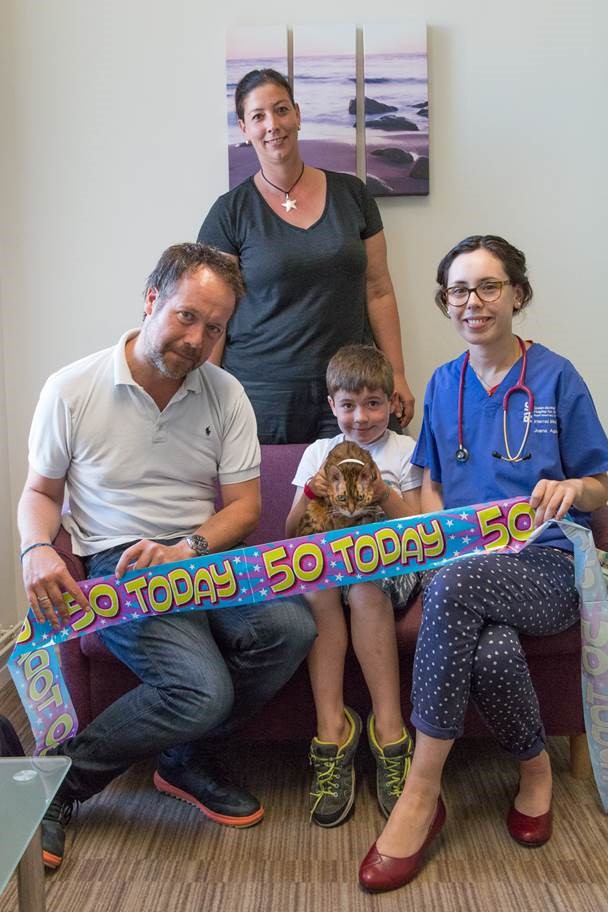Cat Flown in from Germany Cured by Advanced Procedure at the RVC
A couple flew from Germany to England with their cat for treatment thanks to their vet in Germany hearing that Royal Veterinary College (RVC) specialists have expertise in hypophysectomy, an advanced surgical technique.
The RVC was the first veterinary centre in the UK to offer hypophysectomy, which removes the pituitary gland at the base of the brain, to correct a range of debilitating and at times life-threatening conditions. The pituitary gland, and any associated tumour, is removed via the roof of the mouth.
The first RVC hypophysectomy, in 2012, successfully treated a cat with acromegaly, which is also known as hypersomatotropism. Feline acromegaly is characterised by excessive growth hormone secretion, leading to a range of health problems, including diabetes, obesity, respiratory conditions, cardiac disorders and neurological symptoms. Acromegaly is usually caused by a tumour on the pituitary.
Hypophysectomy surgery can also treat dogs and cats with Cushing’s disease (hyperadrenocorticism), as well as animals suffering from non-functional pituitary tumours. The latter do not result in excess hormone production.

The Bengal cat from Germany, called Nala, was the 50th RVC patient to benefit from the RVC’s hypophysectomy expertise. Her acromegaly had caused diabetes and this was proving difficult to control. Veterinary hypophysectomy surgery is not available in Germany but a local specialist consulted about Nala remembered RVC Senior Lecturer in Internal Medicine Dr Stijn Niessen speaking at an international conference about the procedure. She then suggested it to Nala’s owners as a treatment option.
The vast majority of acromegalic cats that have the procedure are cured of diabetes, and it proved successful for Nala as well. Until veterinary specialists became proficient in hypophysectomy, the only treatment option available for cats and dogs with pituitary tumours was radiation therapy, and managing the diabetes mellitus (in case of acromegaly). Radiation therapy, however, is frequently ineffective in such cases, and managing diabetes is often extremely difficult and frustrating for both owners and vets.
Explaining the value of hypophysectomy, Dr Niessen, who established the RVC hypophysectomy clinic in 2012 with neurosurgeon Patrick Kenny, said: “With the pituitary being an incredibly important gland for the functioning of the body, removing it carries certain risks. The removal of the gland when it has become tumorous is, however, the gold standard in human medicine. The procedure is recommended for diseases like acromegaly and Cushing’s. Leaving the tumour in place will cause the body to deteriorate due to overproduction of hormones and eventually the tumour can become so big it causes pressure on the rest of the brain.”
“With the founding of the RVC hypophysectomy clinic four years ago, companion animals can now also benefit from this gold standard treatment. The transdisciplinary approach, where different specialisms work together as one team at RVC Small Animal Referral Hospital, has made this possible. For each case undergoing the procedure, the RVC Internal Medicine, Neurology & Neurosurgery, Anaesthesia and Emergency and Critical Care teams work together to get the best results.”
He added: “When Patrick and I started this clinic four years ago we could not have dreamed of how much impact it would have. Not only have we provided hope to 50 cats and dogs and their human families, where previously there was little reason for hope, but the cases coming through the clinic have also helped us understand why these diseases occur. This has opened up a road towards discovering even more advanced ways of treating, and even preventing, the occurrence of these hormonally active brain tumours, regardless of the species. It never ceases to amaze me that the tumour we just removed from Nala’s brain could hold the answers to designing a cancer cure. But above all, as an animal lover myself, it thrills me to see Nala enjoying life again as part of the Steffen family.”
Nala’s surgery was a success and she has been recovering well. She joins the 85% of cats that do not need any insulin anymore after this procedure and the diabetes has been cured.
Mrs Steffen commented: “We are so happy that we found out about this operation and did not think twice about flying over. I would recommend this procedure to all acromegalic cat owners. We just had to accept the inherent risk of a brain operation like this in order to provide Nala with the best possible chance of a future with the best quality of life. We are so grateful.
“We are on our way back to Germany but with no need this time to pack insulin as part of her luggage, her diabetes is gone and so is her brain tumour. “
In the meantime, the removed tumour tissue is being used in research at the RVC to study why such brain tumours occur in cats, and in humans. The research team at the RVC ultimately want to use such knowledge to prevent brain tumours from occurring in all creatures, great and small.
You may also be interested in:
-
The RVC maintains top performance in Knowledge Exchange Framework for fifth year
The Royal Veterinary College (RVC) has once again secured strong results in the fifth Knowledge …

